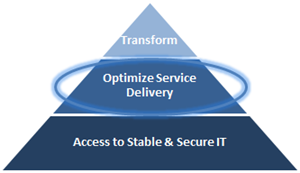A Closer Look at the Nonprofit IT Pyramid: A framework love story in 4 parts (Part Deux)
Last week, we shared a closer look at the foundation of the Nonprofit IT Pyramid, Access to Stable & Secure IT. To continue the biopic on our favorite framework, let’s take a look at an organization using IT at the second level of the pyramid, Optimize Service Delivery.
Optimize Service Delivery
Access to stable and secure technology is essential, but it is just the foundation upon which you can begin to use technology to expand your organization’s service delivery and community impact. In other words, it enables you to start doing really cool, mission-centric things with IT.
At the “Optimize” level, nonprofits use databases and relationship management software, collaboration and engagement tools, social media and fundraising solutions to help them become “bigger, stronger, faster.” (Or, in nonprofit terms, able to serve more clients with better services in a more efficient and effective way.) At this level, not only does your organization have access to the IT tools it needs, but it is savvy in how it deploys those tools to serve clients, integrate services, share institutional knowledge, and strengthen relationships with key stakeholders.
As abz* Austria illustrates, IT at this level is a business enabler and is increasingly an investment in mission, not just an infrastructure cost.
abz* Austria uses CRM software to match more women with jobs
abz* Austria is Austria’s leading women’s organization, and serves more than 3,000 women each year with career coaching, job orientation courses, and IT training to help them develop valuable skills sought by employers. Their long-term vision is to achieve gender equality in the labor market in Austria, but – as their client base grew – abz* faced near-term challenges. A majority of its employer contact information and trainee data were recorded on paper, which made coordinating service delivery ineffective and cumbersome. abz* realized its paper-based process of matching trainees with job opportunities had to go. It was not only limiting their growth, but it was also hampering the quality and professionalism of service they could offer to trainees and employers.
With their sights set on improved data management and service delivery processes, abz* implemented Client Relationship Management (CRM) software, allowing the organization to create one central database of current and past trainees, employers and jobs, and volunteer trainers. No more rifling through paper files, duplicate records, and walls of filing cabinets. The CRM system allowed them to quickly and easily index and sort the skills and certifications of thousands of trainees to help them find suitable employment opportunities. Now, abz* can get important information and job opportunities out to its trainees more efficiently, and can better identify quality matches between candidates and jobs. They are even able to better schedule and deploy their bench of volunteer trainers. The use of CRM allowed the organization to optimize its existing method of service delivery and to expand the reach of its services to more women in Austria.
“Having a database enables far more professional work,” said Daniela Schallert, the Executive Director of abz* Austria. Not only that, but now Daniela can demonstrate to her board the connection between technology and mission. The investment in CRM was an investment in effective program delivery with a direct impact on the organization’s ability to meet its mission.
Now that’s what we call optimizing service delivery.
More, more, more!
Watch the *abz video to hear directly from staff the impact CRM had on their service delivery. And come again next week - we'll look at how technology at the top of the pyramid can transform the way nonprofits take on social challenges.
As you make your way through this 4-part series, we hope the pyramid becomes an increasingly helpful framework to guide your own organization’s IT planning and discussions. It’s simple, but we think that’s what makes it so darn useful. Leave a comment and let me know what you think: Does your organization speak “pyramid?” Have you taken on IT projects that improved your service delivery?
You haven’t read the Nonprofit IT Pyramid paper yet? No wonder you're confused! Get the full story at https://bit.ly/npitpyramid
Part One in this series available here. Part Three in this series available here.
Lindsay Bealko** helps Microsoft Community Affairs put technology know-how in the hands of nonprofits through resources like webinars, NGO Connection Days, and software donations. With several years’ experience in the nonprofit sector, Lindsay understands the unique challenges and opportunities nonprofits face when trying to adopt technology to help them meet their missions. She sometimes tweets at @linzbilks .
